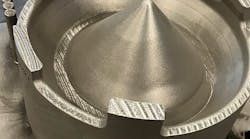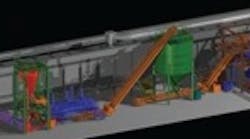Nemak's new sand-handling system functions from the discharge point of the reclamation furnace, fluidizes the sand, and then mixes it with new sand, screens it, cools it, and stores it for reuse.
The recent expansion at Nemak Corp.'s Windsor Aluminum foundry in Ontario includes a new multi-million-dollar system that processes sand as hot as 932°F from the thermal sand-reclamation furnace. Then it cools, stores, and classifies it, transporting it back to the core machines. Foundry Solutions & Design (www.foundrysd.com) designed the system. It began successfully transporting sand in December 2005, just five months after the order was placed.
Once the sand is returned to the core machines it is reused to form the precision cores package that Nemak engineers developed specifically for GM's high-feature 3.6-liter V-6 aluminum cylinder blocks.
Each hour, 20 tons of thermally reclaimed silica sand is processed. In the system, sand is transferred from the discharge end of the thermal sand reclamation furnace to a bulk lifter at an average temperature of 662°F, with a maximum temperature of 932°F. This unit fluidizes the sand using a positive-displacement blower to raise the sand vertically and deposit it into a sand receiver. This receiver acts as a surge hopper for the hot sand prior to cooling. Hot sand exiting the receiver is mixed with new sand, and the resulting mixture is transferred across a vibrating screen designed to remove debris. After screening the sand enters a primary sand cooler. This two-stage fluidized bed cooler uses plant process water to cool the sand to approximately 86°F.
From the discharge of the primary cooler, the sand is transferred on an inclined camwall belt to a rotary screen (1.5-mm openings) atop a 200-ton in-process sand-storage silo. Stored sand is discharged as needed onto another camwall belt and transferred to the final cooler. This final cooler will use both process and chilled water to cool and classify the sand to final specifications, as indicated at the core room.
Larry Ernst is vice president of Foundry Solutions & Design, Atlanta. Read the complete presentation, "Precision Sand Handling Coming to Nemak."
| Mold-Sand Handling, Feeding Raises Productivity, Cuts Maintenance Equipment operators had various problems with inaccurate measurements and materials plugging the conveyors, and the system had no alarms or alert mechanisms to warn the operators of system failures, which delayed their response time. As one component of its renovation project, Wescast chose to replace the metering system with a Mechatron loss-in-weight feeder, part of the AccuRate (www.accuratefeeders.com) line from Schenk Weighing Systems. Two production lines, comprised of four Mechatron feeders and four DisoCont controls, were installed. For each line, one feeder meters the fines and the other a bentonite-clay premix. With accuracies of ±0.25-0.75%, the feeders meter the materials on to a belt conveyor, with sand coming from the sand supply hopper. The feeders are monitored by the DisoCont controls and a HMI package that displays alarms, feed rates, material usage, and operating status. All of the materials from the feeders and sand-supply hopper are conveyed to a muller, where water is added through a separate control loop based on the conductivity of the sand. Then, the sand and clay mix is conveyed to the molding area. Read the complete presentation, "New Mold-Sand Handling and Feeding System Increases Productivity, Cuts Maintenance for Wescast." |










